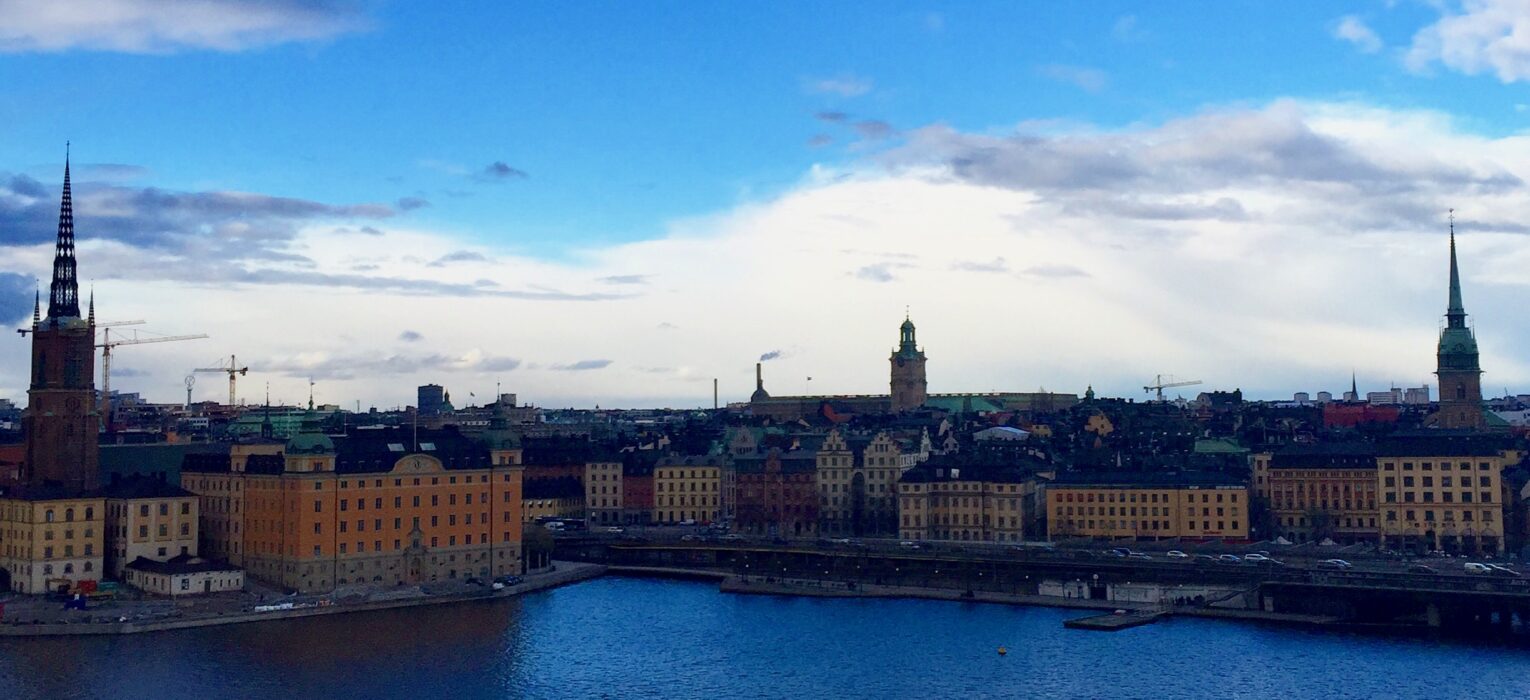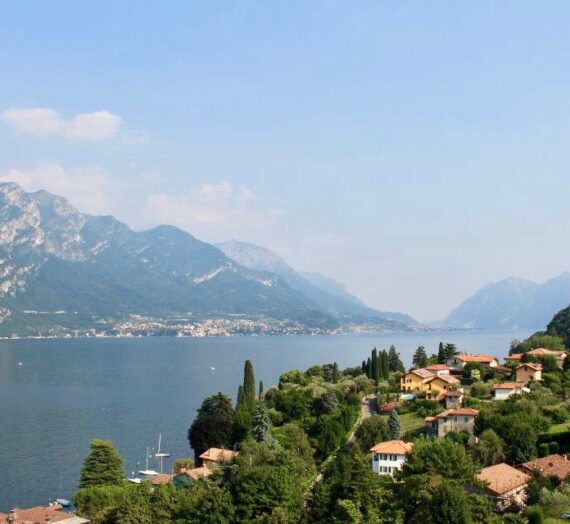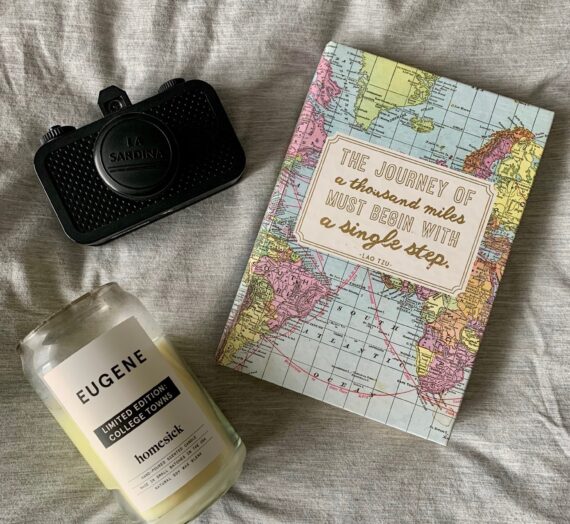There are a seemingly infinite number of backpacking routes through Europe out there. The trip you decide to take depends on several factors, like which countries you want to visit, what kinds of sightseeing you enjoy, and whether you prefer big cities or small towns.

If you enjoy cities and cultural sights and want to get a taste of the north and south of Europe, we’ve got just the backpacking route for you. For some of the best cityscapes, museums, and food, make your way through the capital cities of Oslo, Norway; Stockholm, Sweden; Berlin, Germany; Prague, Czech Republic; Vienna, Austria; and Rome, Italy. This journey is best made through a combination of trains and planes with all your belongings in a backpack.
Here’s your backpacking route through six capital cities in Europe.

1. Oslo, Norway
The first stop on this backpacking route through Europe is Oslo, the capital city of Norway. The city was founded in 1040 and is home to around 673,000 people today.
As the home of budget carrier Norwegian Airlines, it’s become increasingly more convenient and less expensive to fly in and out of Oslo. Plus, there’s a handy train that goes right from the airport to the center of the city.
Oslo is situated on the water and is full of beautiful green spaces and cultural sights. It’s home to several renowned museums, such as the Munch Museum, which houses Edvard Munch’s The Scream; Folkemuseet, a folk museum; and the Viking Ship Museum, among several others.
The city also features many lovely parks. Perhaps the most famous is Frogner Park, which includes hundreds of sculptures that make up the Vigeland Museum. There are many other public parks and open green spaces perfect for exploring as well.
The Norwegian capital is also known for its cultural institutions. One of the most well known is the Oslo Opera House, which sits right on the waterfront. Whether or not you’re a fan of the music, it’s worth visiting this local landmark. Its striking modern architecture is beautiful and functional — you can follow the clean lines up to the roof, where wonderful city and fjord views await you.
Of course, the streets of Oslo are also full of wonderful shops, restaurants, and bars to experience as well. Karl Johans Gate, for instance, is a pedestrian street perfect for finding such places.
Keep in mind, though, that Oslo is known as an expensive city. (Our Air BnB host described it as New York City prices plus twenty percent.) It’s something to consider when you’re planning how much time to spend in each city.
Overall, Oslo is a city with friendly locals, beautiful scenery, and cultural attractions. It’s a perfectly welcoming city for you to begin your journey.

2. Stockholm, Sweden
Next stop on our backpacking route through Europe is Stockholm, Sweden.
To get from Oslo to Stockholm, you can take a bus or train, or combination of the two. The journey does take anywhere from five and a half to seven and a half hours, so it will use up a good chunk of the day. However, having the opportunity to see the open Scandinavian countryside makes it a trip worth taking.
Like Oslo, Stockholm is a waterfront capital. The city is spread out across an archipelago of the Baltic Sea, made up of 14 islands and dozens of bridges. The city charter dates back to the 13th century and is now home to more than one million people.
The Swedish capital is home to historical sights, museums, and classic Scandinavian architecture. One of the city’s most famous attractions is the Vasa Museum, which houses an almost fully intact 17th century warship. There’s also the Nationalmuseum, where you’ll find the country’s largest art collection; Fotografiska, a museum dedicated to photography; and the ABBA Museum, among many others. While it’s full of museums, the city is also brimming with art galleries, literary history, theaters, and parks.
With any new city it’s hard to know where to spend your time, but it seems particularly difficult when the city is on a series of islands. You’ll want to pay a visit to Gamla Stan, the city’s old town. Here you’ll find plenty of tourist attractions, as well as those famous Stockholm waterfront views. Södermalm is a great area to explore as well. It’s a laid back, artsy area full of creative shops, trendy bars and restaurants, and lovely city views. Plus, it’s also home to the Fotografiska.
Sweden’s capital of Stockholm is a cultural paradise. It’s simply bursting with museums, history, and architecture, all with friendly locals in a beautiful setting.

3. Berlin, Germany
After Stockholm, our next capital city is Berlin.
To get from Stockholm to Berlin, you can take a pretty long train journey — around 12 to 15 hours — or a fairly short flight — just about an hour and a half.
With nearly four million people, Berlin is the most populous city on this journey. The city is located along the River Spree and first mentions of the town date back to the 13th century.
Germany’s capital of Berlin is a city with so much history and culture, it’s hard to feel like you’ve even scratched the surface when visiting for a few days. However, by dividing your time between visiting museums, historical sites, and landmarks, you can get a taste of this remarkable city.
In Berlin, recognizing history is of utmost importance. As you walk around the city, you’ll see a black line with metal engravings that read “Berliner Mauer,” or Berlin Wall — an outline marking where the wall once stood. Today, you can still visit Checkpoint Charlie, the most well-known crossing point between East and West Germany, as well as the Berlin Wall Memorial on Bernauer Straße. There are several other history museums and memorials around the city as well.
Berlin is also home to some famous landmarks. Among them is the Brandenburg Gate, an 18th century monument on the site of a former city gate. It’s located near the Reichstag building, where German Parliament meets. Another local landmark is the Fernsehturm, or Television Tower, a tall, thin structure with a metal sphere near the top.
To start off your museum touring, head to Museum Island. You’ll find several museums on this island in the Spree River, which is included on the UNESCO list of World Heritage Sites. Among them are the Alte Nationalgalerie, which features art from several periods, such as Romantic, Neoclassical, and Impressionist; Altes Museum, home to classical art; and Neues Museum, which displays Egyptian and other early history collections.
To see some more modern pieces, pay a visit to Berlinische Galerie. This museum displays modern art, photography, and architecture in their collection and rotating exhibits.
When in Germany, one must also enjoy some local beer. This best done somewhere with communal tables where you can chat with some fellow travelers or locals. A particularly well-known, albeit touristy, option is the Hofbräu Berlin. Here giant beers, massive pretzels, and plates of sausages await you.
Berlin is a city with so many layers, you’ll feel like you’ve barely seen anything by the time you leave. Spend some time exploring its history, art, and landmarks, and don’t forget to have some bier and currywurst along the way.

4. Prague, Czech Republic
The next stop on our backpacking route through Europe is Prague, Czech Republic.
From Berlin, hop on a train or bus to Prague. It’s about a four and a half hour ride through the beautiful German and Bohemian countryside.
Prague, nicknamed “The City of a Hundred Spires” is the capital city of the Czech Republic, or Czechia. The city was founded back in the seventh century and is home to 1.3 million people today.
Situated on the Vltava River, Prague, or Praha, is filled with history and green spaces. It’s a great city to spend some time outdoors, enjoying the local landmarks and beautiful scenery.
At the top of the list of historical landmarks to see is Prague Castle. The castle sits on a hill overlooking the city and dates back to the ninth century. The castle complex includes palaces, churches, and gardens.
Another local sight to see is the Charles Bridge. Spanning the Vltava, the pedestrian bridge was built in the 14th and 15th centuries. Not far from the bridge is the Old Town Square with the Astronomical Clock, the oldest of its kind still in operation.
To enjoy some of the Czech capital’s green spaces, head up to Petřín Lookout Tower on Petřín Hill. The tall steel tower, which looks like a smaller version of the Eiffel tower, houses a staircase and lookout areas where visitors can enjoy sweeping city views.
For more lovely outdoor areas, visit one of the river’s islands, such as Střelecký ostrov. Stroll the island and take in the nature and city views. Festivals and cultural events often take place on the island, so if you’re lucky you may get to experience some local festivities as well!
The town of Prague looks like it’s right out of a storybook. With its tall spires, terra cotta roofs, and beautiful greenery, plus plenty of historic sites, it’s a lovely place to wander.

5. Vienna, Austria
After Prague, our backpacking route through Europe takes us to Vienna, Austria.
To get there, take another train or bus ride from Prague over to Vienna. The journey takes about four hours.
Situated along the Danube River, Vienna was once a Roman settlement. In the 11th century it was a significant trading post and today the Austrian capital home to nearly two million people.
Vienna, or Wien, is a music and art lover’s paradise. The city, which is consistently named one of the top cities for quality of life, is full of cultural attractions.
Many famous musicians have worked in Vienna, including Wolfgang Amadeus Mozart and Ludwig van Beethoven. Tributes to the city’s musical history are everywhere; statues of acclaimed composers dot the streets, flower beds shaped like musical symbols decorate the parks, and famous musical sights are everywhere.
The city is home to several opera houses, but perhaps the best known is the Vienna State Opera. Whether or not you plan to catch a performance, this stately institution is worth a visit. Other famous musical landmarks fill the city as well, like Mozart’s house (Mozarthaus Vienna).
The City of Music is also home to dozens of museums. One of the most impressive is the Belvedere Museum. The museum is within Belvedere Palace, which once served as Prince Eugene of Savoy’s summer residence. The museum features art from the Medieval period to the present day and includes some particularly incredibly pieces (such as works by Gustav Klimt).
Another great place in the city for art is MuseumsQuartier. This large area is home to a several museums, many of which display modern art, like mumok (Museum Moderner Kunst Stiftung Ludwig Wien).
Vienna is a beautiful city bursting with art, music, and history. Coupled with its timeless architecture and scenic parks, the Austrian capital is a simply wonderful place to be.

6. Rome, Italy
The final stop on this backpacking route through Europe is Rome, Italy.
To get to Rome from Vienna, you can go by train, which takes around 11 to 12 hours, or you can fly, which takes just more than an hour and a half.
The story goes that in the 750s BC, brothers Romulus and Remus, who were raised by a she-wolf, decided to found a new city. However, when they came to the seven hills where the city stands today, they got into an argument which ended with Remus’s death. Romulus then went on to start the city on his own, which he named after himself.
In the twenty-plus centuries since then, Rome has seen a fair bit — like the rise and fall of an empire, monarchs, Papal rule, and world wars, for a start. Today the Italian capital city on the banks of the Tiber River is home to more than two million people.
In Roma, art, history, and food take center stage. With its plethora of landmarks, the city is like a massive open air museum, best explored on foot between plates of pasta.
Most of Rome’s top attractions are found near the city center. Just along Via dei Fori Imperiali you’ll find the Colosseum, also known as the Flavian Amphitheater, and the Roman Forum. Just on the other side of Piazza Venezia are several other attractions, including the Pantheon, one of the best preserved ancient Roman structures; the Trevi Fountain, an imposing Baroque piece; the Spanish Steps, or Scalinata di Trinità dei Monti; and Piazza Navona, among others.
Vatican City, the smallest country in the world, is contained within the city of Rome. Vatican City is home to Vatican Museums, Saint Peter’s Square, and Saint Peter’s Basilica. The public papal audience takes place here as well.
As mentioned, one of the top priorities in is the food. When in Rome, you must try the three traditional Roman pastas: amatriciana, cacio e pepe, and carbonara. And one mustn’t forget about all that pizza, gelato, wine, and limoncello as well.
With centuries of history layered throughout the city, Rome is the perfect city to simply wander the streets. Take in the culture, try the food, and enjoy your time in the Eternal City.
—

Backpacking Tips
- Moving from city to city is best done with a backpack. When traipsing all over new towns, trying to find your way, the last thing you need is a suitcase weighing you down. If you’ve never tried traveling with a backpack before, you may enjoy it more than you think. (Ever since we got ours a few years ago, we’ve used them for basically every trip.)
- There are tons of backpacks out there, but our favorite brand is Tortuga. The backpacks are comfortable, stylish, and versatile. Plus, they also make packing cubes, which are a necessity. With packing cubes, you can roll your clothes and store them compactly in each pouch. They’re awesome space savers.
- When backpacking, make sure that you pack as many versatile items as possible. Your goal is for all of your tops to go with all of your bottoms for maximum mix-and-match potential. Also, when you’ll be in cities with different climates, like on this route, make sure this includes layers.
- Finally, pack light. You can bring or grab a bit of detergent and do small loads of laundry along your way, even just in the bathroom sink. Plus, you’re going to be in large cities, so anything you realize you need along the way is easy to find. Run out of toothpaste? They sell that in Prague! Realize once you get to Rome that you haven’t brought enough warm weather clothes? No worries, pop into H&M and pick up an inexpensive dress. This way, you’ll be dressed like the locals and have a fun new piece to bring home! It can be daunting to set off for days or weeks without much stuff, but it’ll really make your travels all the easier.

Offsetting Environmental Damage From Travel
One of the biggest problems travelers face today is how to deal with the damage our trips have the environment. Pollution from airplanes, single-use items, and other travel conveniences are having a negative impact on the earth. As this backpacking guide through Europe includes quite a bit of traveling between cities, it’s a necessary topic here.
There are extensive guides on this out there, but we’ll touch on just a couple things here, specific to moving from one place to another while traveling. One thing we can do to lessen pollution is travel slowly — this means opting for trains, gas-efficient cars, and other forms of public transportation, which cause less damage to the environment.
However, sometimes we just don’t have the time to travel slowly and need to fly. In this case, there are tons of carbon offsetting programs where we can donate money to offset the damage done by air travel. Some are apparently more reputable than others, but there are good ones out there. A great place to start is the UN’s Carbon Offset Platform. Here you can learn all about carbon offsetting and find some environmental projects to support. Several large, reputable companies partner with NativeEnergy and some airlines have their own programs as well.
—

If you’re looking for a trip full of art, history, and scenery, this backpacking route through Europe is just for you. These six capital cities offer a balance of it all and offer you a taste of the northern and southern parts of the continent. Cheers!







Viennese Dreams: Quick Travel Guide for Vienna, Austria - Papers and Airplanes
[…] Read more about how to fit Vienna into a longer trip full of European capitals here. […]